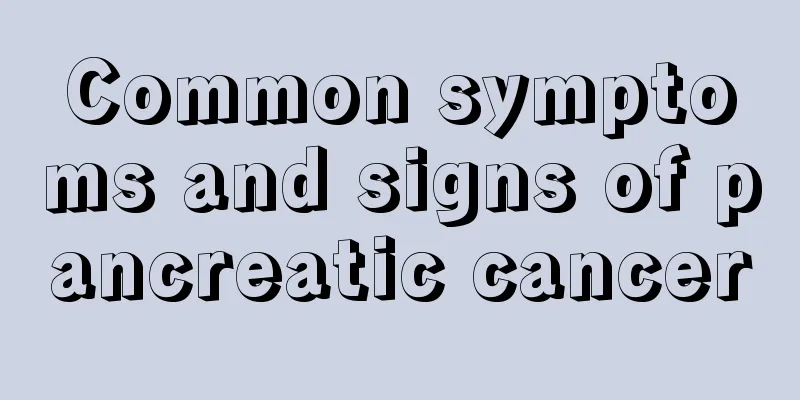Common symptoms and signs of pancreatic cancer

|
The early symptoms of pancreatic cancer are mainly upper abdominal discomfort or dull pain, bloating, and distension, accounting for about 70%-90%. Since food after meals stimulates the secretion of bile and pancreatic juice, and there is obstruction at the exit, the pressure in the bile duct and pancreatic duct increases, which can aggravate the pain or discomfort. Another obvious symptom is loss of appetite or changes in eating habits, especially dislike for greasy and high-animal protein foods. More than 70% of patients have a significant weight loss without any other cause. In severe cases, the weight can drop by more than 30kg within 2-3 months. A small number of patients may also have diarrhea or Steatorrhea is caused by the inability of the patient's bile and pancreatic juice to enter the intestines, resulting in incomplete digestive function. Jaundice (80%-90%) is a characteristic symptom of pancreatic head cancer. Since pancreatic cancer has the biological characteristics of infiltrating around ducts such as the bile duct and pancreatic duct, jaundice may appear early or after the aforementioned symptoms. The color of the stool becomes lighter as the jaundice deepens, and finally becomes white clay. The color of urine becomes darker and darker until it becomes soy sauce color. Most patients may develop skin itching due to obstructive jaundice, and scratches can be seen all over the body during physical examination. A small number of patients develop thrombophlebitis.The pain in patients with advanced pancreatic cancer is particularly severe, often involving the waist and back (about 1/4 of patients), which persists without relief, making it impossible to lie flat, and often requires a forward prone position, all night long, which is very painful. This is the result of the cancer invading the abdominal nerves. When the tumor involves the body of the pancreas, this clinical manifestation is quite common. Digestive dysfunction, ascites, and lumps often occur in the late stage. Pancreatic cancer not only affects the exocrine function of the pancreas, but also its endocrine function. About 30% of patients have varying degrees of glucose metabolism disorders, and the condition of patients with diabetes in the past may worsen. There are no warning signs for pancreatic cancer. The most common symptom is upper abdominal pain, which indicates that the abdominal lymph nodes are involved (accounting for more than 90%). There may also be loss of appetite, nausea and vomiting, constipation (accounting for 50%), weight loss (usually all feelings in the early stage, accounting for 50%), diarrhea, abdominal distension, belching and hiccups. Other symptoms include itchy skin, lower limb edema, sleep disorders and fatigue. The above manifestations vary depending on the location of the tumor. If the tumor is located in the tail of the pancreas, there is generally no jaundice, and other manifestations are basically similar. |
<<: Smoking is the main cause of lung cancer
>>: Eating fruits and vegetables regularly can reduce the incidence of gastric cancer
Recommend
Does tangerine cause heatiness? Will eating tangerines cause internal heat?
There are many kinds of fruits in the citrus fami...
The difference between milk calcium and calcium lactate, a reasonable understanding can better supplement nutrition
Generally speaking, many people confuse lactic ac...
The drug of choice for psychomotor seizures
Psychomotor seizures usually occur at around the ...
What are the symptoms of gastric inflammation?
As the saying goes, gastrointestinal health is th...
It turns out that there are 5 types of antenatal checkups for caesarean section
What are the prenatal examination items for caesa...
What is the best medicine for burns?
Burns by fire are not like burns by boiling water...
How to treat arrhythmia, Chinese medicine is effective
Arrhythmia has become a very common disease, and ...
How much does radiotherapy for brain cancer cost
How much does radiotherapy for brain cancer cost?...
What are some tips for dealing with peeling on the face?
The skin on the face is a part that people attach...
What kind of clothes look better with men's leather shoes
Many male friends do not know how to dress themse...
Can breast cancer patients reconstruct after mastectomy?
Breast cancer patients can undergo reconstruction...
How to make various coffees
I believe that many people who have some knowledg...
How can we completely eliminate the early symptoms of bone cancer?
When patients have various early symptoms of bone...
Can I wash my feet and have a massage during pregnancy?
Foot washing and massage is a popular health care...
Does endometrial cancer have brain metastasis?
Endometrial cancer refers to cancer of the uterin...









